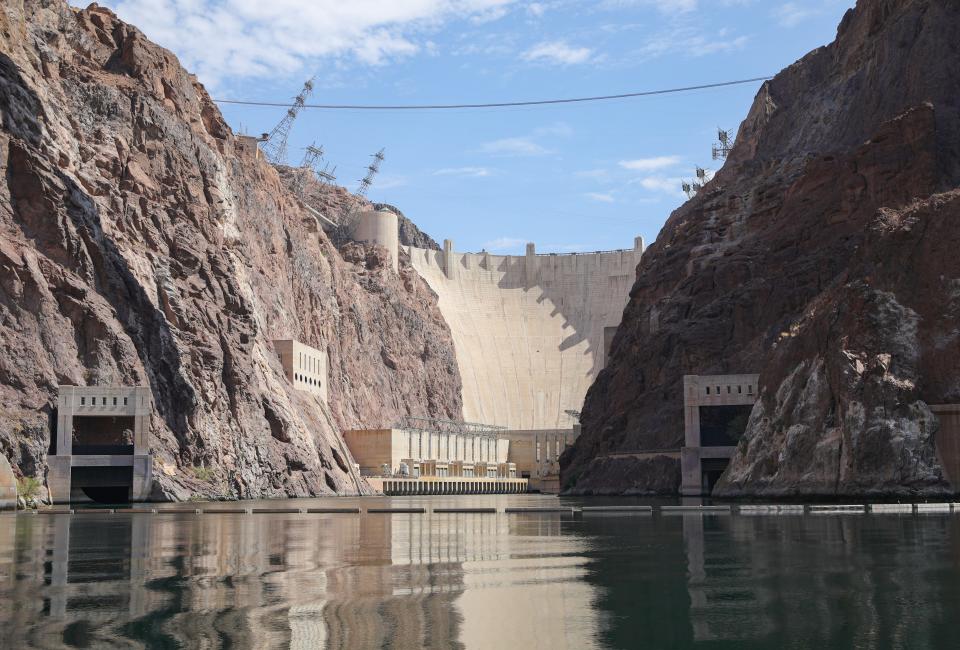Gov. Ducey wants Arizona to invest $1B in desalination, other water infrastructure
Gov. Doug Ducey on Monday proposed spending $1 billion from the state’s general fund over three years to help “secure Arizona’s water future for the next 100 years.”
In his final State of the State address, the governor said the budget he sends to lawmakers will prioritize water infrastructure including desalination.
“Instead of just talking about desalination, the technology that made Israel the world’s water superpower,” he said, “how about we pave the way to make it actually happen?”
Long discussed as an idea to deliver some of Mexico’s share of the Colorado River without drawing down Lake Mead, seawater desalination on the Sea of Cortez would pump treated water to Morelos Dam near Yuma for distribution in Mexico. The U.S. parties paying into the program would then take some of Mexico’s river water as compensation.
While desalination was the only new water initiative Ducey specified in his speech, his office later emailed a statement noting that the budget would promote new technologies and encourage reuse and efficiency upgrades.
Arizona, Salt River Project and partners in Mexico, California, Nevada and the federal government participated in a binational report on the desalination proposal in 2020. It is estimated that two plants, each situated on the sea’s eastern shore south of Puerto Pe?asco and each producing 100,000 acre-feet a year, would cost $3 billion to $4 billion in upfront costs. That and annual operating costs would create a price of $2,000-$2,200 per acre-foot, which consultants determined would be in line with other potential sources of new water.
An acre-foot is 326,000 gallons, which the Arizona Department of Water Resources estimates can support about three households for a year.
The binational desalination report estimated that the river’s users in the Southwest and Mexico will face a water deficit of about 1.2 million acre-feet a year by 2035, so a 200,000-acre-foot project would cover about a sixth of the need. Water recycling, conservation or other projects would need to cover the rest.
In a recent interview, Arizona Water Resources Director Tom Buschatzke told The Arizona Republic that such a plant could come online in the next decade. With climate change creating a hotter and drier river basin, he said, “it’s being looked at much more seriously from both sides” of the border.

Arizona already has committed $100 million over the next two years pay users to keep water in storage behind Hoover Dam and is also in talks with California and Nevada for a potential water-recycling project in Southern California that would allow California to reuse the water and the other states to take a larger share of the river. That project could essentially create 161,000 acre-feet a year.
Desalination carries with it environmental costs, such as heavy energy use and disposal of the resulting brine either at sea or in deep wells. For that reason, conservation groups have often suggested seeking other solutions first.
Rural crisis: Megafarms and deeper wells are draining the water beneath rural Arizona – quietly, irreversibly
Haley Paul, policy director for the National Audubon Society in Arizona, said desalination in Mexico “could certainly be on the table” if Mexico remains interested in the proposal.
“It’s not our end-all and be-all,” she said, though Audubon would not oppose continuing the binational conversation.
To secure the state’s water future, though, she said desalination would need to be paired with other programs such as groundwater recharge, stormwater capture, forest health restoration and wastewater reuse.
The Environmental Defense Fund likewise released a statement supporting broader measures.
"In addition to desalination, augmentation must include projects that treat and reuse wastewater, replenish local groundwater, and capture and recharge stormwater to benefit communities and ecosystems," said Kevin Moran, senior director of EDF's Colorado River program. "State lawmakers need to authorize rural Arizona communities to begin managing and conserving groundwater and strengthen our Active Management Areas’ programs and standards."
Active Management Areas are designated groundwater management zones authorized for urban areas such as metro Phoenix by a 1980 groundwater management act.
Sen. Regina Cobb, R-Kingman, has tried to lead the way in preserving water resources. She has introduced bills in the last few years that attempt to rein in groundwater use but was stymied by the chairperson of the House committee on natural resources, energy and water, Rep. Gail Griffin, R-Hereford.
Going into this legislative session, a Mohave County water users’ study committee that Cobb chairs has voted to recommend legislation that would enable the creation of rural groundwater management areas in counties that request them.
Ducey's pledge to put $1 billion in resources to the water problem encouraged Cobb, who said the governor's state of the state speech was the best she's heard from him.
The idea to work with Mexico on a desalination plant on the Sea of Cortez was not just about money, she said, but also about the details of the negotiations involved. One question she had was whether Mexico would agree to allow Arizona to use up some of Mexico's allocations in the Colorado River in return for helping to build the desalination plant.
Cobb's groundwater ideas "weren't touched on" by Ducey on Monday, she noted.
Drought: Colorado River forecast improves with early snow, but the outlook could still change
Republic reporter Ray Stern contributed to this report.
Brandon Loomis covers environmental and climate issues for The Arizona Republic and azcentral.com. Reach him at [email protected].
Environmental coverage on azcentral.com and in The Arizona Republic is supported by a grant from the Nina Mason Pulliam Charitable Trust. Follow The Republic environmental reporting team at environment.azcentral.com and @azcenvironment on Facebook, Twitter and Instagram.
This article originally appeared on Arizona Republic: Gov. Doug Ducey proposes spending $1B on water infrastructure
